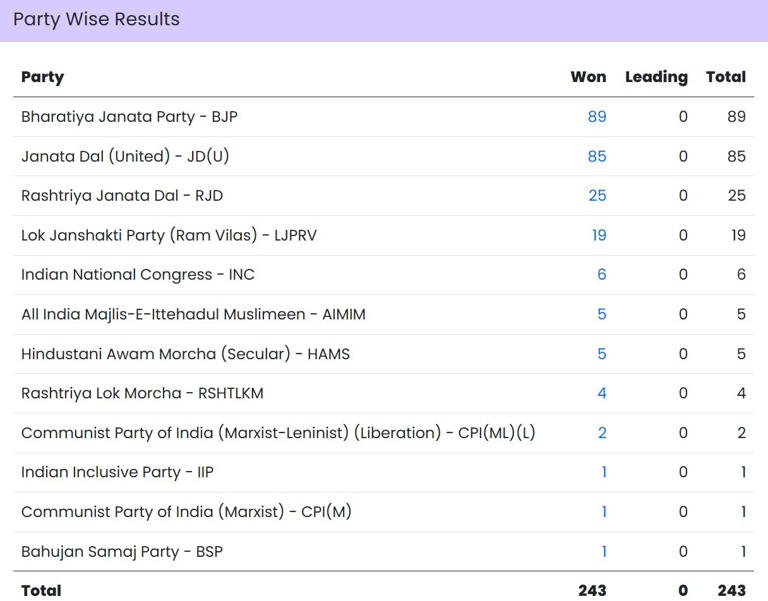The Bihar Election Results 2025 saw a dramatic landslide victory for the BJP-led National Democratic Alliance (NDA), returning Chief Minister Nitish Kumar for another term. Yet, beneath the headline numbers, the Rashtriya Janata Dal (RJD)—which led the Mahagathbandhan alliance with the Congress—emerged as the party with the highest vote share, highlighting the gap between popularity and actual seat wins.

Why RJD Got the Votes but Not the Seats
The RJD contested 143 seats, bagging 25 wins, yet commanded 23% of the total votes—the highest among all parties. In contrast, the BJP contested 101 seats and won 89, but its vote share was 20.07%, reflecting focused strength rather than spread popularity.
What is vote share?
Vote share indicates the percentage of total votes received by a party across all constituencies contested. A high vote share often means broad public support, but if these votes are spread thinly, resulting in second-place finishes, they may not translate into seats.
This year, RJD’s expansive contesting meant it could accumulate a large number of votes even where it narrowly lost. The NDA parties, by fielding candidates in limited but winnable seats, converted their votes more efficiently into victories. RJD’s wider spread saw its votes “wasted” in losing constituencies, boosting overall vote share but not the seat tally.
Seat Tally and Major Outcomes
- NDA’s Sweep: Out of 243 seats, the NDA bagged 202 seats, with BJP winning 89 and JDU 85. Smaller partners like Lok Janshakti Party (Ram Vilas) contributed 19, Hindustani Awam Morcha (HAM) won five, Rashtriya Lok Morcha four.
- Mahagathbandhan Rout: RJD finished with just 25 seats, Congress with 6, CPI(ML)L 2, CPI(M) 1, CPI none, for a total of 35 seats.
- RJD’s Vote Count: RJD received 1,15,46,055 votes; BJP, 1,00,81,143 votes.

Political and Strategic Takeaways
RJD’s result illustrates that a high vote share, without strategic seat selections or concentrated wins, doesn’t ensure government formation. The NDA’s alliance kept its voter base consolidated, translating electoral support into actual seats.
PM Modi and Nitish Kumar attributed the victory to “unity,” decisive “development politics,” and NDA’s strong grassroots machinery. Congress’s strategy and Mahagathbandhan’s coordination failed to turn voter enthusiasm into electoral wins, further weakened by internal rifts and muddled messaging.
Conclusion
While RJD remains Bihar’s most voted-for party, the NDA’s strategic seat targeting and alliance dynamics handed the BJP and JDU a resounding win. The 2025 mandate underscores the difference between winning hearts and winning seats—and the importance of converting popularity into effective electoral success.

